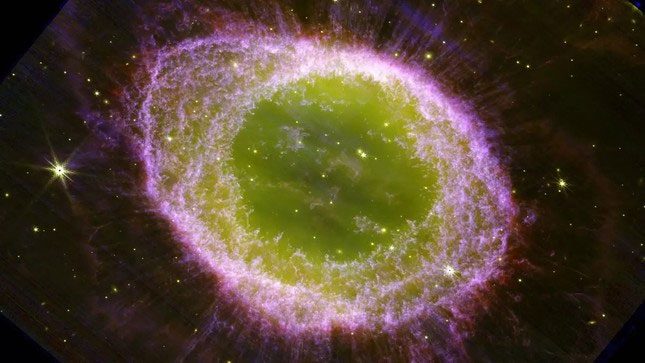Astronomers Reveal “The Final Chapters in the Life of a Star” Through the James Webb Space Telescope.
The James Webb Space Telescope has captured images of the Ring Nebula resembling a glowing green and purple eye.
The images showcase the Ring Nebula, also known as Messier 57 (M57), located approximately 2,200 light-years away from us.

The Ring Nebula captured clearly by the James Webb Space Telescope.
The Ring Nebula is the glowing remnant of a long-dead star, a type of astronomical object known as a “planetary nebula.” At its center lies a white dot symbolizing a white dwarf star—the remnant of the core of that extinct celestial body.
When stars similar in size to the Sun exhaust their fuel for nuclear fusion, they can no longer counteract their own internal gravitational forces, ending the balance that has kept the star stable for billions of years.
As the core collapses, the outer layers of the star, where nuclear fusion is still occurring, are blown away. This initially causes the star to swell into a red giant, a phase that the Sun will undergo in about 5 billion years when it expands around the orbit of Mars, engulfing the inner planets, including Earth.
These outer layers eventually cool and disperse to form various shapes, including thin clouds, expanding bubbles, or nebula rings like M57.
Nick Cox, a scientist, stated: “These images are not only aesthetically pleasing but also provide significant scientific insights into the evolutionary process of stars. By studying the Ring Nebula with the James Webb Telescope, we hope to deepen our understanding of the lifecycle of stars and the elements they release into the universe.”
“We are witnessing the final chapters in the life of a star, a preview of the distant future of the Sun,” scientists emphasized.


















































